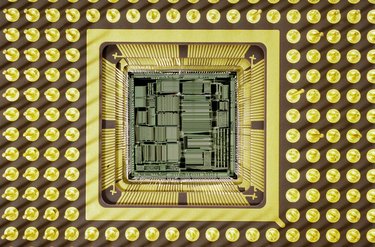
Computers are complex machines that appear to be very intelligent but in reality are only very fast. Six essential components provide the various capabilities that a computer needs to do its job and appear to be so smart. Of course, no computer works without some form of electrical power, either from an outlet, a battery or a solar cell. It's what the computer does with the electricity that's so interesting. Chips are made of silicon with embedded transistors that can be turned on or off, which is the language of 1's and 0's that computers understand.
Central Processing Unit
Video of the Day
The CPU handles all computations and is a traffic cop for the entire machine, directing what happens and when. A CPU consists of the control unit, or CU, and the arithmetic logic unit, or ALU. The CU gets program instructions from the computer's memory, deciphers them and executes them. The ALU does the math and makes decisions. CPUs exist in the form of a silicon chip with millions of transistors. Some computers have more than one processor, and some chips contain more than one CPU.
Video of the Day
Random Access Memory
Random access memory is the primary storage for the computer. The CPU talks directly with RAM through a bus that connects all of the computer's components electronically. RAM is very fast, operating in the nanosecond range, or billionths of a second. RAM is called volatile memory since it loses its contents when the power is removed. RAM, like the CPU, is made up of thousands or millions of transistors on a silicon chip.
Read-Only Memory
Read-only memory, or ROM, stores pre-configured information for the computer that's usually used during the startup process. ROM chips are much like RAM chips, except the computer doesn't store information to ROM chips, but can only read from them. Some chips, such as the Basic Input-Output System are erasable read-only memory. These are also known as EPROM chips, and a special process is used to write new information to these chips. ROM chips are non-volatile, meaning they don't lose information when power is removed.
Secondary Storage
Since RAM is volatile and computers do not normally write to ROM, computers use a form of secondary storage called disk storage. Disks are small round platters with an oxide coating that can hold a magnetic charge. The charge for a particular spot on the disk can be either on or off, again supporting the computer language of 1s and 0s. Other forms of secondary storage include solid state disk, which is an array of non-volatile memory chips that mimic a normal disk. Flash drives are a form of solid state drive.
Motherboard
The motherboard is a circuit board that houses the processor, memory and ROM chips. Motherboards contain slots for additional cards as well as the bus connections that tie everything together and enable the other components to communicate with each other. They also contain integrated connection ports for hard disks, USB devices, modems, mice and keyboards. Most modern motherboards contain integrated network interfaces and modems.
Software
Without software computers are just sand, gold and oxide in a box. Software for startup is loaded on ROM chips, and the computer reads instructions from them to know what to do next. Operating system software for running the computer is typically loaded onto the hard disk drive and is loaded in as the last part of startup. Software applications like word processors and spreadsheets let a user actually do productive things with the computer.